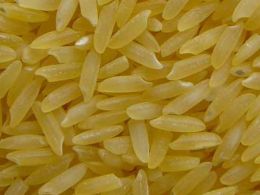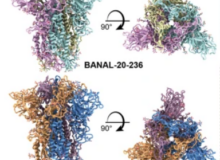by Allison Wilson, PhD and Jonathan Latham, PhD
The biotech industry and its supporters have promoted GMO Golden Rice for decades as an urgently needed solution to vitamin A deficiency.
But, in a surprising twist, the US Food and Drug Administration (FDA) has concluded its consultation process on Golden Rice by informing its current developers, the International Rice Research Institute (IRRI), that Golden Rice does not meet the nutritional requirements to make a health claim.
Golden Rice refers to GMO rice plants modified to produce beta-carotene (also called provitamin A) in their grain. This latest version of Golden Rice contains three added genes. Two specify enzymes in the β-carotene biosynthesis pathway, and are taken from bacteria and maize. The third specifies a (non-antibiotic) selectable marker protein used in the modification process (Paine et al. 2005).
First described in the scientific literature over 18 years ago by public sector researchers (Ye et al. 2000), various public and private sector iterations of Golden Rice have subsequently been produced (Bollenidi et al. 2014). These represent repeated efforts to increase beta-carotene levels, while still maintaining plant vigor and yield.

The Golden Rice version submitted to FDA by IRRI, called event GR2E, is the only Golden Rice to have ever been submitted for regulatory approval. In 2017, it was approved for import by regulators in Australia, New Zealand, and Canada. Originally developed by Syngenta, Golden Rice GR2E is now funded by the Gates Foundation.
The letter containing FDA’s statement on GR2E’s lack of nutritional benefit was posted on May 25th, 2018 (FDA 2018b).
In IRRI’s consultation with FDA, IRRI stated it has no intention of marketing Golden Rice in the US. Nevertheless, in part because rice is wind pollinated, it is expected that, if commercialized, Golden Rice GR2E will contaminate U.S. rice imports.
Since 1996, when they were first grown commercially, many hundreds of GMO contamination events have been documented (Price and Cotter, 2014). This includes contamination by an unreleased GMO rice that led to a massive disruption of the global rice market in 2006-08. Hence the need to consult with US and other national authorities.
As is standard for GMO foods (since FDA has no legal powers to approve or reject them) FDA has responded to IRRI’s consultation request, which is voluntary, by noting that its maker has concluded that Golden Rice is safe (Pelletier 2006). Thus FDA’s letter states:
“Based on the safety and nutritional assessment IRRI has conducted, it is our understanding the IRRI concludes that human and animal food from GR2E rice is not materially different in composition, safety, or other relevant parameters from rice-derived food currently on the market except for the intended beta-carotene change in GR2E rice.“
But the letter from FDA goes further. It asserts that:
“the concentration of β-carotene in GR2E rice is too low to warrant a nutrient content claim.“
In an attached memo, FDA notes the beta-carotene content of unmilled Golden Rice GR2E ranged from 0.50-2.35ug/g (FDA 2018a). That is, beta-carotene levels in Golden Rice are both low and variable. This compares to beta-carotene levels measured in non-GMO foods such as fresh carrot (13.8-49.3ug/g; Schaub et al. 2017); Asian greens (19.74-66.04 ug/g; Chandra-Hioe et al. 2017); and spinach (111ug/g; Li et al. 2017).
FDA notes the mean value of beta-carotene for GR2E is 1.26ug/g. This is, paradoxically, less beta-carotene than the 1.6ug/g measured for the original iteration of Golden Rice (Ye et al. 2000).
Greenpeace once calculated that such low levels would necessitate a person to eat 3.75 kg of Golden Rice per day to receive an adequate amount of beta-carotene.
Rapid Degradation of β-carotene in Golden Rice
In the same memo, FDA also states,
“IRRI acknowledged that it expects the actual dietary intakes to be lower given …that β-carotene levels in food containing GR2E rice would decline over time due to storage…”
Degradation of beta-carotene during storage is a problem that may prove even more troublesome for the proposed nutritional benefits of Golden Rice than its initial low levels.
Unnoticed by the media, a 2017 paper published in the Journal of Agricultural and Food Chemistry reported that the beta-carotene content of Golden Rice GR2E at harvest is short-lived (Schaub et al. 2017).
This study found Golden Rice retained only 60% of its original beta-carotene levels after 3 weeks of storage and just 13% after 10 weeks.
The apparent explanation is that the beta-carotene in Golden Rice is unstable in the presence of oxygen. Thus, under normal storage conditions, the beta-carotene in Golden Rice grains will rapidly degrade.
Under tropical farming, storage, and household conditions, degradation may be faster still.
In any event, the low levels and rapid degradation of beta-carotene measured in Golden Rice GR2E seem a significant blow to the likelihood that Golden Rice will fulfill expectations. That is, remedy Vitamin A deficiencies in malnourished and impoverished people, in countries like the Philippines and Bangladesh (Stone and Glover 2016; Hilbeck and Herren 2016).
Reports of Higher Levels of β-carotene
Higher levels of beta-carotene have nevertheless sometimes been reported for Golden Rice GR2E (e.g. FSANZ 2017; Schaub et al. 2017; Paine et al. 2005). For example, the second FDA memo notes mean beta-carotene levels in milled rice from the same experiment were 3.57ug/g. Schaub et al. (2007) reported 31.1ug/g at the start of their degradation study.
All the higher levels are explained by some combination of the following: measurement of total carotenoids rather than beta-carotene alone; milling the rice; use of non-AOAC (Association of Official Analytical Chemists) extraction methods; differences in genetic backgrounds (e.g. Schaub et al. 2017 use GR2E Kaybonnet, which is unsuitable for the Philippines); growth under greenhouse rather than field conditions; and/or differences in field environments or growing seasons. In other words, the low levels communicated to FDA seem to be the most accurate and realistic.
Is Golden Rice GR2E Safe?
Despite FDA’s letter, the biosafety of Golden Rice GR2E is contested. Testbiotech and other researchers have pointed out that key human safety and efficacy studies are lacking, especially for target populations (Then and Bauer-Panskus 2018; Stone and Glover 2016; Schubert 2008). Specific health concerns include unintended nutritional effects of carotenoid biosynthesis or its degradation products and because certain components of the carotenoid pathway can be toxic (Schubert 2008; Stone and Glover 2016).
Also of interest is that FDA’s assessment of GR2E safety was based on estimated annual U.S. per capita rice consumption of 11.8kg. Annual consumption in the Philippines averages over 110kg (Muthayya et al. 2014).
In 2017, IRRI/PhilRice submitted to the Philippine Department of Agriculture an application for the production and testing of Golden Rice GR2E. It has yet to be granted.
References
Bollinedi, et al. (2014). Marker Assisted Biofortification of Rice with Pro-vitamin A Using Transgenic Golden Rice Lines: Progress and Prospects. Indian Journal of Genetics, 74(4), 624-630. Available at: http://www.indianjournals.com/ijor.aspX?target=ijor:ijgpb&volume=74&issue=4s&article=016
Chandra-Hioe et al. (2017) Lutein and β-Carotene in Selected Asian Leafy Vegetables. J Food Chem Nanotechol, 3(3), pp.93-97. Available at: http://unitedscientificgroup.com/journals/ets/articles/v1n1/jfcn-043-maria-chandra-hioe.pdf
FDA (2018a) GR2E Biotechnology Notification File No. 000158 Note to the File Date: May 8, 2018. Available at: https://www.fda.gov/downloads/Food/IngredientsPackagingLabeling/GEPlants/Submissions/ucm607450.pdf
FDA (2018b) GR2E Response Letter RE: Biotechnology Notification File No. BNF 000158 Available at: https://www.fda.gov/downloads/Food/IngredientsPackagingLabeling/GEPlants/Submissions/ucm608797.pdf
FSANZ (2017) Supporting Document 1. Safety Assessment Report (at Approval) – Application A1138. Food Derived from Provitamin A Rice Line GR2E. Available at: http://www.foodstandards.gov.au/code/applications/Documents/A1138_SD1_at approval.pdf
Hilbeck, A. and H. Herren (2016) Millions Spent, No One Served: Who Is to Blame for the Failure of GMO Golden Rice? Independent Science News: Available at:
https://www.independentsciencenews.org/health/millions-spent-who-is-to-blame-failure-gmo-golden-rice/
Li et al. (2017) Selected Nutrient Analyses of Fresh, Fresh-Stored, and Frozen Fruits and Vegetables. Journal of Food Composition and Analysis, 59, 8-17. Available at: http://www.frozenfoodfacts.org/assets-foundation/misc/images/JFCA%20Frozen%20Food%202017.pdf
Muthayya, S. et al. (2014) An Overview of Global Rice Production, Supply, Trade, and Consumption. Annals of the New York Academy of Sciences, 1324(1), pp.7-14. Available at: https://nyaspubs.onlinelibrary.wiley.com/doi/full/10.1111/nyas.12540
Paine, Jacqueline A., et al. (2005) Improving the Nutritional Value of Golden Rice Through Increased Pro-Vitamin A Content. Nature Biotechnology 23.4: 482. Available at: http://eprints.icrisat.ac.in/210/1/NatureBiot23_482-487_2005.pdf
Pelletier, David L. (2006) FDA’s Regulation of Genetically Engineered Foods: Scientific, Legal and Political Dimensions. Food policy 31.6: 570-591. Available at: http://www.independentsciencenews.org/wp-content/uploads/2014/01/Pelletier-2006-Scienti%EF%AC%81c-legal-and-political-dimensions-.pdf
Price, Becky, and Janet Cotter. (2014) The GM Contamination Register: a Review of Recorded Contamination Incidents Associated with Genetically Modified Organisms (GMOs), 1997–2013. International Journal of Food Contamination 1.1: 5. Available at: https://foodcontaminationjournal.springeropen.com/articles/10.1186/s40550-014-0005-8
Schaub, Patrick, et al. (2017) Nonenzymatic β-Carotene Degradation in Provitamin A-Biofortified Crop Plants. Journal of Agricultural and Food Chemistry 65.31: 6588-6598. Available at: https://www.gefree.org.nz/assets/pdf/2017-carotene-degradation.pdf
Schubert, David R. “The problem with nutritionally enhanced plants.” Journal of medicinal food 11.4 (2008): 601-605. Available at: https://www.stopogm.net/sites/stopogm.net/files/NutritionallyEnhancedPlants.pdf
Stone, G. D., & Glover, D. (2016) Disembedding Grain: Golden Rice, the Green Revolution, and Heirloom Seeds in the Philippines. Agriculture and Human Values, 34(1): 87-102. Available at: http://pages.wustl.edu/files/pages/imce/stone/stone_glover_2016_golden_rice.pdf
Then and Bauer-Panskus (2018) Testbiotech on Risk Assessment for Golden Rice by FSANZ February 2018. Available at: https://www.testbiotech.org/en/publikationen
Ye, Xudong, et al. (2000) Engineering the Provitamin A (β-carotene) Biosynthetic Pathway into (Carotenoid-Free) Rice Endosperm. Science 287.5451: 303-305. Available at: http://www.uniroma2.it/didattica/FisiolBiotecVeg/deposito/Golden_rice_.Ye_et_al..pdf



